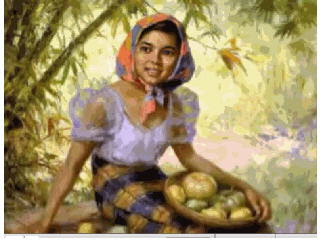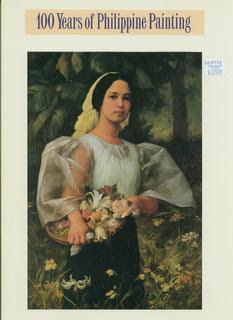Biography of Fernando Amorsolo Biography of Fernando Amorsolo
Biography of Fernando Amorsolo
Fernando Cueto Amorsolo (May 30, 1892 - April 26, 1972) is one of the most important artists in the history of painting in the Philippines.[1] Amorsolo was a portraitist and painter of rural Philippine landscapes. He is popularly known for his craftsmanship and mastery in the use of light. Born in Paco, Manila, he earned a degree from the Liceo de Manila Art School in 1909.
Fernando Amorsolo was born on May 30, 1892 in Paco, Manila to Pedro Amorsolo, a bookkeeper, and Bonifacia Cueto. Amorsolo spent his childhood in Daet, Camarines Norte, where he studied in a public school and was tutored at home in Spanish reading and writing. After his father’s death, Amorsolo and his family moved to Manila to live with Don Fabian de la Rosa, his mother's cousin and a Philippine painter. At the age of 13, Amorsolo became an apprentice to De la Rosa, who would eventually become the advocate and guide to Amorsolo's painting career. During this time, Amorsolo's mother embroidered to earn money, while Amorsolo helped by selling watercolor postcards to a local bookstore for 10 centavos each. Amorsolo's brother, Pablo, was also a painter.
Amorsolo's first success as a young painter came in 1908, when his painting Levendo Periodico took second place at the Bazar Escolta, a contest organized by the Asociacion Internacional de Artistas. Between 1909 and 1914, Amorsolo enrolled at the Art School of the Liceo de Manila, where he earned honors for his paintings and drawings.
After graduating from the Liceo, he entered the University of the Philippines' School of Fine Arts, where Dela Rosa worked at the time. During college, Fernando Amorsolo's primary influences were the Spanish court painter Diego Velazquez, John Singer Sargent, Anders Zorn, Joaquín Sorolla y Bastida, Claude Monet, Pierre-Auguste Renoir, and Ignacio Zuloaga. Amorsolo's most notable work as a student at the Liceo was his painting of a young man and a young woman in a garden, which won him the first prize in the art school exhibition during his graduation year. To make money during school, Amorsolo joined competitions and did illustrations for various Philippine publications, including Severino Reyes’ first novel in Tagalog, Parusa ng Diyos (God’s Punishment), and Iñigo Ed. Regalado's Madaling Araw (Dawn). He also illustrated for the religious Pasion books. Amorsolo graduated with medals from the University of the Philippines in 1914.
After graduating from the University of the Phillipines, Amorsolo worked as a draftsman for the Bureau of Public Works, as a chief artist at the Pacific Commercial Company, and as a part-time instructor at the University of the Philippines (where he would work for 38 years).[4] After three years as an instructor and commercial artist, Amorsolo was given a grant to study at the Academia de San Fernando in Madrid, Spain by Filipino businessman Enrique Zobel de Ayala. During his seven months in Spain, Amorsolo sketched at museums and along the streets of Madrid, experimenting with the use of light and color.] Through De Ayala’s grant, Amorsolo was also able to visit New York, where he encountered postwar impressionism and cubism, which would be major influences on his work.
Amorsolo set up his own studio upon his return to Manila and painted prodigiously during the 1920s and the 1930s. His first important painting the 1922 Rice Planting (1922), which appeared on posters and tourist brochures, becoming one of the most popular images of the Commonwealth era. Beginning in the 1930s, Amorsolo's work was exhibited widely both in the Philippines and abroad.[6] His optimistic, pastoral images set the tone for Phillipine painting before World War II. Except for his darker World War II-era paintings, Amorsolo painted quiet and peaceful scenes throughout his career.
Amorsolo was sought after by influential Filipinos including Luis Araneta, Antonio Araneta and Jorge Vargas. Amorsolo also became the favorite Philippine artist of United States officials and visitors in the Philippines. Due to his popularity, Amorsolo had to resort to photographing his works and pasted and mounted them in an album. Prospective patrons could then choose from this catalogue of his works. Amorsolo did not create exact replicas of his trademark themes; he recreated the paintings by varying some elements.
His works later appeared on the cover and pages of children's textbooks, in novels, in commercial designs, in cartoons and illustrations for the Philippine publications such The Independent, Philippine Magazine, Telembang, Renacimiento Filipino, and Excelsior. He was the director of the University of the Philippine’s College of Fine Arts from 1938 to 1952.
During the 1950s until his death in 1972, Amorsolo averaged to finishing 10 paintings a month. However, during his later years, diabetes, cataracts, arthritis, headaches, dizziness and the death of two sons affected the execution of his works. Amorsolo underwent a cataract operation when he was 70 years old, a surgery that did not impede him from drawing and painting.Two months after being confined at the St. Luke’s Hospital in Manila, Amorsolo died of heart failure on April 24, 1972 at the age of 79.
Four days after his death, Amorsolo was conferred as the First Philippine National Artist in Painting at the Cultural Center of the Philippines by Ferdinand E. Marcos.
During his lifetime, Amorsolo was married twice and had 14 children. In 1916, he married Salud Jorge, with whom he had six children. After Jorge’s death in 1931, Amorsolo married Maria del Carmen Zaragoza, with whom he had eight more children. Among her daughters are Sylvia Amorsolo Lazo and Luz Amorsolo. Five of Amorsolo’s children became painters themselves. Amorsolo was a close friend to the Philippine sculptor Guillermo Tolentino, the creator of the Caloocan City monument for Philippine hero Andres Bonifacio.
source: wikipedia
art,
beauty quotations ,
songs,
poem,
Fernando Amorsolo,
paintings,
landscapes












































